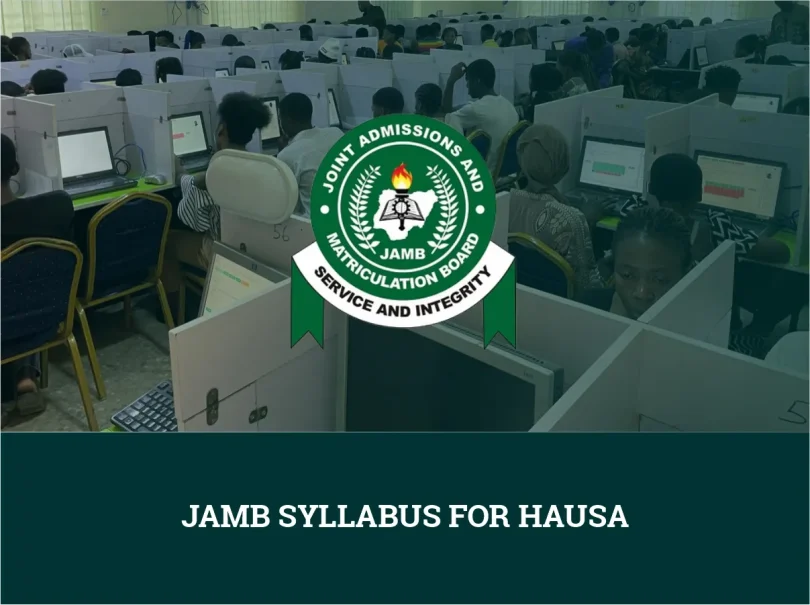JAMB has officially released the syllabus for Hausa, and it’s an important tool for anyone preparing for the exam. If you are planning to write Hausa in JAMB, getting a copy of the syllabus should be your first step. The JAMB Syllabus for Hausa shows you all the topics you need to study and helps you focus your revision on what really matters.
In this article, you will find the detailed JAMB Hausa syllabus laid out clearly for you. We have also included a list of recommended textbooks that will guide your reading and help you understand the concepts better. Plus, there’s more useful information to support your study journey.
JAMB Syllabus For Hausa
Below is a section of the recommended texts for the JAMB Hausa paper. Candidates are advised to make full use of these books as part of their study materials. Additionally, ensure that you use the JAMB Syllabus for Hausa during your revision to cover all important topics and improve your chances of success in the exam.
| Topics/Contents/Notes | Objectives |
|---|---|
| (a) Ƙa’idojin Rubutu (Orthography) – Alphabetization, spelling, rules of word merger and division, punctuation and paragraphing in standard Hausa. | i. Recognize Hausa orthographical rules ii. Apply these rules iii. Identify linguistic errors (grammar, spelling, etc.) |
| (b) Auna Fahimta (Comprehension) – Contextual questions from short unseen passage (~200 words). | i. Read written Hausa texts ii. Comprehend texts in context iii. Interpret meanings/functions of words iv. Acquire vocabulary v. Recognize central issues vi. Draw conclusions from evidence |
| (c) Tsarin Rubutun Insha’i (Composition Techniques) – Argumentative, descriptive, dialogue, expository, narrative, and letter writing. | i. Understand Hausa composition techniques ii. Recognize segments of composition iii. Identify different composition types |
| (d) Fassara (Translation) i. Types of translation ii. Rules of translation iii. Problems in translation iv. Techniques of translation | i. Translate idioms and new words from English to Hausa ii. Recognize types of translation iii. Understand techniques iv. Identify translation problems |
| (e) Tsarin Sauti (Phonology) i. Consonants: phonation, place/manner ii. Vowels: tongue/lip position; monophthongs & diphthongs iii. Tone: high, low, falling iv. Syllable structure: open/close, light/heavy v. Vowel length: long/short vi. Phonological processes: assimilatory (palatalization, labialization, vowel harmony), non-assimilatory (insertion, deletion) | i. Analyse sound production ii. Assess vowel importance iii. Distinguish phonetic sound attributes iv. Recognize syllable count/types v. Understand phonological processes |
| (f) Ƙirar Kalma (Morphology) i. Roots and stems ii. Affixation: prefix, infix, suffix iii. Gender and number inflections iv. Deriving nouns/adjectives from verbs | i. Explain roots and stems ii. Understand inflectional processes iii. Understand derivational processes iv. Distinguish between morphological processes |
| (g) Ginin Jumla (Syntax) i. Word classes: nouns, verbs, pronouns, etc. ii. Grammatical categories: tense, mood, gender, number iii. Sentence structure: verbal, nominal, stabilizer use iv. Sentence types: simple, compound, complex v. Clauses: types and functions | i. Analyse word combinations into phrases/sentences ii. Detect grammatical errors iii. Recognize written ideas iv. Construct correct sentences v. Use correct tenses/gender/number vi. Distinguish sentence structures and clauses |
| (h) Ma’ana (Semantics) i. Lexical meanings: ambiguity, synonyms, antonyms ii. Figures of speech: idioms, proverbs | i. Analyse meaning-generation in Hausa ii. Build vocabulary iii. Recognize sentence meanings/functions iv. Use context-appropriate words v. Form meaningful sentences |
You can download the full JAMB Syllabus For Hausa here:
JAMB Recommended Textbooks For Hausa
These are the books recommended by JAMB to help you prepare well for the Hausa exam. Using these books alongside the syllabus will make your revision more focused and effective.
| Book Category | Recommended Texts |
|---|---|
| General Language Texts | Introduction to Hausa Grammar, Galadanci, M.K.M. (1976), Zaria: Longman |
| Rayayyen Nahawun Hausa, Junju, M.H. (1980), Zaria: NNPC | |
| Fassarar Hausa, Muhammad, Y.M. (2005), Zaria: ABU Press | |
| Tsarin Sauti Da Nahawun Hausa, Sani, M.A.Z. (1999), Ibadan: UP Plc | |
| Exam Focus: Hausa Language, Sani, M.A.Z. et al (2000), Ibadan: UP Plc | |
| Grammar of Hausa, Skinner, N. (1977), Zaria: NNPC | |
| Darussan Hausa 1 – 3, Yahaya, I.Y. et al (1992), Ibadan: UP Plc | |
| Literature and Culture | Waƙoƙin Bikin Aure, Bichi, A.Y. (1979), Lagos: Nelson |
| Rabe-Raben Adabin Baka da Muhimmancinsa Ga Rayuwar Hausawa, Dangambo, A. (1984), Kano: T.P.C. | |
| Makaɗa Da Mawaƙan Hausa, Gusau, S.M. (1991), Kaduna: Fisbas Media Service | |
| Kowa Ya Sha Kiɗa, Ibrahim, M.S. (1977), Zaria: Longman | |
| Hausa Customs, Madauci, I. et al (1992), Zaria: ABU Press | |
| Ɗanmaraya Jos Da Waƙoƙinsa, Umar, M.B. (1976), Ibadan: OUP | |
| Wasannin Tashe, Umar, M.B. (1977), Zaria: NNPC | |
| Dictionaries (Ƙamusai) | A Hausa –English Dictionary and English-Hausa Vocabulary, Bargery, G.P. (1951), London: OUP |
| An English-Hausa Dictionary, Newman, R.M. (1997), Ibadan: Longman | |
| Sabon Ƙamus Na Hausa Zuwa Turanci, Newman and Newman (1977), Ibadan: UPLS | |
| Kamus Na Turanci Da Hausa, Skinner, N. (1993), Zaria: NNPC | |
| Ƙamusun Hausa Na Jami’ar Bayero ta Kano, CSNL (2006), Kano: CSN |
In all of these, don’t forget to get the JAMB Hausa past questions and use them to practice ahead of the examination. We wish you the best of luck in your exams!
If you have any questions, feel free to ask them in the comments, and we will respond quickly. Also, don’t forget to share this post with others who may find it helpful.







Leave a Comment